会计学:企业决策的基础exercises-chapter4答案
基础会计学——第四章课后练习参考答案

第四章课后习题复习思考题1.会计科目就是对会计要素的具体内容进行科学分类的项目为了准确的记录每一项经济业务发生后引起的会计要素中个别数量发生的数量变动必须对会计要素包括的具体内容进行科学分类并赋予每个类别一个特定的名称这个名称就是会计科目所以会计科目就是对会计要素的具体内容进行科学分类的项目2.第一必须结合会计要素的特点全面反映会计要素的内容第二既要符合企业内部经济管理的要求又要符合对外报告满足宏观经济管理的要求第三会计科目的设臵既要保持统一性又要考虑灵活性第四会计科目的设臵既要适应社会发展的需要又要保障持相应的稳定性第五会计科目的设臵应保持会计科目总体上的完整性和会计科目之间的互斥性3.可将其分为资产类会计科目所有者权益类会计科目负债类会计科目共同类会计科目损益类会计科目成本类会计科目4.账户是对会计要素的具体内容进行科学分类反应和监督并具有一定格式的工具它是用来分类连续系统的记录和反映各种会计要素增减变化情况及其结果的一种手段如果把企业发生的经济业务连续系统全面的反映和监督下来提供各种会计信息就需要一个记录的载体这个载体就是按照会计科目所规范的内容而设臵的会计账户5.会计账户与会计科目二者既有区别又有联系二者都是对会计要素具体内容的分类会计科目是账户的名称两者分类的口径和反映的经济内容一致区别表现在会计科目只有名称仅说明反映的经济内容是什么而账户既有名称又有结构具有一定的格式既能说明账户反映的经济内容是什么又系统的监督和反映经济业务的增减变化会计科目主要是为了开设账户和填制会计凭证之用而账户则是系统的提供某一个具体会计要素的会计资料是为了编制会计报表和经济管理之用6.账户的经济内容是指会计核算和核算的具体内容按经济内容可以分为资产类账户所有者权益类账户负债类账户成本费用类账户收入类账户利润类账户7.账户的用途是指通过在账户中的记录能够提供哪些会计核算指标也是设臵和运用账户的目的账户的结构是指在账户中怎样记录经济业务如何取得所需的会计核算资料也就是账户的借方登记什么贷方登记什么期末账户有没有余额在一般情况下余额在哪一方描述什么样的经济内容意义为了正确的运用账户来记录经济业务掌握账户在提供核算指标方面的规律性有必要在账户按会计要素分类的基础上进一步对账户按用途和结构分类8.账户按用途和结构可以分为盘存类账户财务成果类账户计价对比类账户成本呢计算类账户调整类账户跨期摊提类账户资本类账户结算类账户练习题一填空题1.会计科目格式会计科目企业实际2.账户性质3.会计要素4.财政部资产类负债类共同类所有者权益类成本类损益类5.会计科目增加减少增加额减少额6.财务成果形成财务成果计算7.债权结算债务结算债权债务结算8.是截至到本月至的利润或亏损“本年利润”“利润分配”9.抵减附加抵减附加10.借二单项选择题1.D2.D3.B4.A (5700+800-5600=900)5.B6.B7.A8.A9.A10.B11.C12.D13.A14.D三多项选择题1.A B C D2.A C3.A C E4.A B C D E5.A B C D E6.A D E7.A B C8.A B C9.B C10.A B D11.A C12.A C13.A B C四判断改错题1.错2.错3.对4.错(会计科目没有格式)5.错6.错7.对8.错(可以编多借多贷的会计分录尽量不编多借多贷会计分录)9.对10.对11.错12.错13.对14.对15.错(年终结转后。
会计学:企业决策的基础exercises-chapter4答案

SOLUTIONS TO EXERCISESEx 4–1 a. Book valueb. Materialityc. Matching principled. Unrecorded revenuee. Adjusting entriesf. Unearned revenueg. Prepaid expensesh. None (This is an example of “depreciation expense.”)Ex. 4–2Income Statement Balance SheetAdjusting Entryab NE I D NE I Dc I NE I I NE Id NE I D NE I De NE I D D NE Df I NE I NE D IEx. 4–3 a. Rent Expense .......................................................................................... 240,000Prepaid Rent .............................................................................. 240,000 To record rent expense for May ($1,200,000 ÷ 5 months =$240,000 per month).b. Unearned Ticket Revenue ................................................................... 148,800Ticket Revenue .......................................................................... 148,800 To record earning portion of season ticket revenue relatingto May home games.Interest Payable (375)$50,000 x 9% annual rate x 1/12 = $375.(2) Accounts Receivable ...................................................................... 10,000Consulting Fees Earned .................................................... 10,000 To record ten days of unbilled consulting fees at $1,000per day.b. $2,250 ($50,000 x 9% x 6/12 = $2,250)c. $15,000 ($25,000 - $10,000 earned in December, 2002)Ex. 4–5 a. The balance of TWA’s Advance Ticket Sales account represents unearned revenue—that is, amounts collected from customers prior to rendering the relatedservices (air travel). As TWA has an obligation to render these services, theAdvanced Ticket Sales account appears among the liabilities in TWA’s balancesheet.b. TWA normally reduces the balance of this liability account by rendering services tocustomers—that is, by providing flights for which the customers have purchasedtickets. On some occasions, however, TWA reduces the balance of this liability bymaking cash refunds to customers.Interest Payable......................................................................... 1,200 To record interest accrued on bank loan during December.2. D epreciation Expense: Office Building ............................................ 1,100Accumulated Depreciation: Office Building ...................... 1,100 To record depreciation on office building ($330,000 ÷ 25years ⨯1/12 = $1,100).3. A ccounts Receivable ............................................................................ 64,000Marketing Revenue Earned .................................................... 64,000 To record accrued Marketing revenue earned in December.4. I nsurance Expense (150)Prepaid Insurance (150)To record insurance expense (1,800 ÷ 12 months = $150).5. U nearned Revenue ............................................................................... 3,500Marketing Revenue Earned .................................................... 3,500 To record portion of unearned revenue that had becomeearned in December.6. S alaries Expense .................................................................................... 2,400Salaries Payable ......................................................................... 2,400 To record accrued salaries in December.b. $62,650 ($64,000 + $3,500 - $1,200 - $1,100 - $150 - $2,400).Ex. 4–7 a. The total interest expense over the life of the note is $5,400 ($120,000 ⨯ .09 ⨯6/12 = $5,400).The monthly interest expense is $900 ($5,400 ÷ 6 = $900).b. The liability to the bank at December 31, 2002, is $121,800 (Principal, $120,000 +$1,800 accrued interest).c. 2002Oct. 31 Cash ........................................................................................ 120,000Notes Payable .......................................................... 120,000 Obtain from bank six-month loan with interest at9% a year.d. Dec. 31 Interest Expense (900)Interest Payable (900)To accrue interest expense for December on notepayable ($120,000 ⨯ 9% ⨯1/12).e. The liability to the bank at March 31, 2003, is $124,500, consisting of $120,000principal plus $4,500 accrued interest for five months.Ex. 4–8 a. May 1 Cash ........................................................................................ 300,000Notes Payable .......................................................... 300,000 Obtained a three-month loan from National Bankat 12% interest per year.May 31 Interest Expense .................................................................. 3,000Interest Payable ...................................................... 3,000 To record interest expense for May on notepayable to National Bank ($300,000 ⨯ 12% ⨯1/12 =$3,000).b. May 1 Prepaid Rent ......................................................................... 180,000Cash ............................................................................ 180,000 Paid rent for six months at $30,000 per month.May 31 Rent Expense ........................................................................ 30,000Prepaid Rent ............................................................ 30,000 To record rent expense for the month of May.c. May 2 Cash ........................................................................................ 910,000Unearned Admissions Revenue .......................... 910,000 Sold season tickets to the 70-day racing season.May 31 Unearned Admissions Revenue ....................................... 260,000Admissions Revenue .............................................. 260,000 To record admissions revenue from the 20 racingdays in May ($910,000 ⨯ 20/70 = $260,000).d. May 4 No entry required.e. May 6 Prepaid Printing .................................................................. 12,000Cash ............................................................................ 12,000 Printed racing forms for first 30 racing days.May 31 Printing Expense.................................................................. 8,000Prepaid Printing ...................................................... 8,000 To record printing expense for 20 racing days inMay.f. May 31 Concessions Receivable ..................................................... 16,500Concessions Revenue ............................................ 16,500 Earned 10% of refreshment sales of $165,000 duringMay.Something to Consider:Effects of omission of May 31 adjusting entry for rent expense on May 31 financialstatements:Revenue Not affectedExpenses Understated (by May’s rent of $30,000)Net Income Overstated (because May rent expense was not recognized)Assets Overstated (Prepaid Rent should be reduced by portion expiredin May)Liabilities Not affectedOwners’ Equity Overstated (because net income is overstated)Ex. 4–9 a. Materiality refers to the relative importance of an item. An item is material if knowledge of it might reasonably influence the decisions of users of financialstatements. If an item is immaterial,by definition it is not relevant to decisionmakers.Accountants must account for material items in the manner required by generallyaccepted accounting principles. However, immaterial items may be accounted forin the most convenient and economical manner.b. Whether a specific dollar amount is “material”depends upon the (1) size of theamount and (2) nature of the item. In evaluating the size of a dollar amount,accountants consider the amount in relation to the size of the organization.Based solely upon dollar amount, $2,500 is not material in relation to the financialstatements of a large, publicly owned corporation. For a small business however,this amount could be material.In addition to considering the size of a dollar amount, accountants must alsoconsider the nature of the item. The nature of an item may make the item“material”to users of the financial statements regardless of its dollar amount.Examples might include bribes paid to government officials, or theft of companyassets or other illegal acts committed by management.In summary, one cannot say whether $2,500 is a material amount. The answerdepends upon the related circumstances.c. Two ways in which the concept of materiality may save time and effort foraccountants are:1. Adjusting entries may be based upon estimated amounts if there is little or nopossibility that the use of an estimate will result in material error. For example,an adjusting entry to reflect the amount of supplies used may be based on anestimate of the cost of supplies remaining on hand.2. Adjusting entries need not be made to accrue immaterial amounts ofunrecorded expenses or unrecorded revenue. For example, no adjusting entriesnormally are made to record utility expense payable at year-end.Ex. 4–10 a. None (or Materiality). Accounting for immaterial items is not “wrong”or a “violation” of generally accepted accounting principles; it is merely a waste of time.The bookkeeperis failing to take advantage of the concept of materiality, which permits chargingimmaterial costs directly to expense, thus eliminating the need to recorddepreciation in later periods.b. Matching.c. Realization.Ex. 4–11 a. Accounts likely to have required an adjusting entry are:1. Investments2. Accounts Receivable3. Inventories4. Prepaid Expenses5. Deferred Income Taxes6. Buildings7. Machinery and Equipment8. Intangible Assets9. Accounts Payable10. Accrued Liabilities11. Income Taxes Payable12. Deferred Compensation and Other LiabilitiesNote to the Instructor: The adjustments required for many of the accounts listedabove are discussed in subsequent chapters. Some are beyond the scope of anintroductory course.SOLUTIONS TO PROBLEMS20 Minutes, Easy PROBLEM 4–1FLORIDA PALMS COUNTRY CLUBPROBLEM 4–1FLORIDA PALMS COUNTRY CLUB (concluded)b.1. Accruing unpaid expenses.2. Accruing uncollected revenue.3. Converting liabilities to revenue.4. Converting assets to expenses.5. Accruing unpaid expenses.6. Converting assets to expenses.7. No adjusting entry required.8. Accruing unpaid expenses.c. The clubhouse was built in 1925 and has been fully depreciated for financial accountingpurposes. The net book value of an asset reported in the balance sheet does not reflect the asset’s fair market value. Likewise, depreciation expense reported in the income statement does not reflect a decline in fair market value, physical obsolescence, or wear-and-tear.40 Minutes, Medium PROBLEM 4–2ENCHANTED FORESTPROBLEM 4–2ENCHANTED FOREST (concluded)b.1. Accruing uncollected revenue.2. Accruing unpaid expenses.3. Converting assets to expenses.4. No adjusting entry required.5. Accruing unpaid expenses.6. Accruing uncollected revenue.7. Converting liabilities to revenue.8. Accruing unpaid expenses.9. Accruing unpaid expenses.c.Income Statement Balance SheetAdjustment Revenue Expenses =NetIncome Assets = Liabilities +Owners’Equity1. I NE I I NE I2. NE I D NE I D3. NE I D D NE D4. NE NE NE NE NE NE5. NE I D NE I D6. I NE I I NE I7. I NE I NE D I8. NE I D NE I D9. NE I D NE I Dd. $340 ($12,000 x 0.85% x 4/12)e. Original cost of buildings .......................................................................................$600,000Accumulated depreciation: buildings (prior to adjusting entry 3 inpart a) ...........................................................................................................................$310,000 December depreciation expense from part a ..................................................2,000Accumulated depreciation, buildings, 12/31 ...................................................(312,000) Net book value at December 31 ..........................................................................$288,00025 Minutes, Strong PROBLEM 4–3SEA CATa. (1) Age of the catamaran in months = accumulated depreciation÷monthly depreciation.Useful life is given as 10 years, or 120 months.Cost $46,200 ÷ 120 months = $385 monthly depreciation expense.Accumulated depreciation of $9,240 ÷ $385 monthly depreciation = 24 months.(2) Tickets used in June (14)5Tickets outstanding on June 30 ($825÷ $15) (55)Tickets sold to resort hotel on June 1 (20)(3) Prepaid rent of $6,000 ÷ 5 months remaining = $1,200 monthly rentalexpense.(4) $1,400 x 12/8 = $2,100 original cost.Since 4 months of the 12-month life of the policy have expired, the $1,400 ofunexpired insurance applies to the remaining 8 months. This indicates a monthly costof $175, computed as $1,400 ÷ 8. Therefore, the 12-month policy originally cost$2,100, or 12 x $175.30 Minutes, Medium PROBLEM 4–4CAMPUS THEATERPROBLEM 4–4CAMPUS THEATER (concluded)b. (1) Eight months (bills received January through August). Utilities bills are recorded asmonthly bills are received. As of August 31, eight monthly bills should have beenreceived.(2) Seven months (January through July). Depreciation expense is recorded only inmonth-end adjusting entries. Thus, depreciation for August is not included in theAugust unadjusted trial balance.(3) Twenty months ($14,000 $700 per month).c. Corporations must pay their income taxes in several installment payments throughout theyear. The balance in the Income Taxes Expense account represents the total amount ofincome taxes expense recognized since the beginning of the year. But Income TaxesPayable represents only the portion of this expense that has not yet been paid. In theexample at hand, the $4,740 in income taxes payable probably represents only the income taxes expense accrued in July, as Pickwood should have paid taxes accrued in the first two quarters by June 15.50 Minutes, Strong PROBLEM 4–5KEN HENSLEY ENTERPRISES, INC.PROBLEM 4–5KEN HENSLEY ENTERPRISES, INC. (continued)c. Monthly rent expense for the last two months of 2002 was $2,000 ($6,000 ÷ 3 months). The$21,000 rent expense shown in the studio’s trial balance includes a $2,000 rent expense for November, which means that total rent expense for January through October was $19,000 ($21,000 - $2,000). The monthly rent expense in these months must have been $1,900($19,000 ÷ 10 months). Thus, it appears that the studio’s monthly rent increased by $100 (from $1,900 to $2,000) in November and December.15 Minutes, Medium PROBLEM 4–6KOYNE CORPORATION。
会计学-企业决策的基础 答案

管理会计作业(chapter16-20)Chapter 16 P757 16.5AChapter 16 P761 16.4BChapter 17 P802 17.3Aa. Department One overhead application rate based onmachine-hours:ManufacturingOverhead = $420,000 = $35 per machine-hour Machine-Hours 12,000Department Two overhead application rate based on direct labor hours:ManufacturingOverhead = $337,500 = $22.50 per direct labor hourDirect Labor Hours 15,000Chapter 17 P805 17.8Ad. The Custom Cuts product line is very labor intensive in comparison to the Basic Chunksproduct line. Thus, the company’s current practice of using direct labor hours toallocate overhead results in the assignment of a disproportionate amount of total overhead to the Custom Cuts product line. If pricing decisions are set as a fixed percentage above the manufacturing costs assigned to each product, the Custom Cuts product line isoverpriced in the marketplace whereas the Basic Chunks product line is currently priced at an artificially low price in the marketplace. This probably explains why sales of Basic Chunks remain strong while sales of Custom Cuts are on the decline.e. The benefits the company would achieve by implementing an activity-based costing systeminclude: (1) a better identification of its operating inefficiencies, (2) a better understanding of its overhead cost structure, (3) a better understanding of the resource requirements of each product line, (4) the potential to increase the selling price of Basic Chunks to make it more comparable to competitive brands and possibly do so without having to sacrificesignificant market share, and (5) the ability to decrease the selling price of Custom Cuts without having to sacrifice product quality.Chapter 18 P835 18.1B. Ex.18.1a. job costing (each project of a construction company is unique)b . both job and process costing (institutional clients may represent unique jobs)c. job costing (each set of equipment is uniquely designed andmanufactured)d . process costing (the dog houses are uniformly manufactured in high volumes)e. process costing (the vitamins and supplements are uniformlymanufactured in high volumes)Chapter 18 P841 18.3A4,000 EU @ $61.50 = $246,000 b4,000 EU @ $13.50 = $54,000Chapter 18 P845 18.2Ba. (1) $49 [($192,000 + $48,000 + $54,000) ÷ 6,000 units](2) $109 [($480,000 + $108,000 + $66,000) ÷ 6,000 units](3) $158 ($49 + $109)(4) $32 ($192,000 ÷ 6,000 units)(5) $18 ($108,000 ÷ 6,000 units)b. In evaluating the overall efficiency of the Engine Department, management wouldlook at the monthly per-unit cost incurred by that department, which is the cost of assembling and installing an engine ($109 in part a).Chapter 20 P918 20.1Ad. No. With a unit sales price of $94, the break-even sales volume in units is 54,000 units:Unit contribution margin = $94 - $84 variable costs = $10Break-even sales volume (in units) = $540,000$10= 54,000 unitsUnless Thermal Tent has the ability to manufacture 54,000 units (or lower fixed and/or variable costs), setting the unit sales price at $94 will not enable Thermal Tent to break even.Chapter 20 P918 20.2AChapter 20 P920 20.6ASales volume required to maintain current operating income:Sales Volume ?Fixed Costs + Target OperatingIncomeUnit Contribution Margin?$390,000 + $350,000= $20,000 units$37。
会计基础第四章试题及答案

会计基础第四章试题及答案一、单项选择题(每题1分,共10分)1. 会计的基本职能是()。
A. 核算和监督B. 审计和监督C. 审计和核算D. 监督和控制2. 会计要素中,反映企业财务状况的是()。
A. 资产B. 负债C. 所有者权益D. 收入、费用和利润3. 会计的基本假设包括()。
A. 会计分期B. 货币计量C. 持续经营D. 所有上述选项4. 会计信息的质量要求中,要求信息具有可比性是()。
A. 可靠性B. 相关性C. 可理解性D. 可比性5. 会计核算的基础是()。
A. 历史成本B. 公允价值C. 现值D. 实际成本6. 会计科目的设置应遵循()。
A. 合法性原则B. 相关性原则C. 经济实质重于形式原则D. 所有上述选项7. 会计凭证是()。
A. 记录经济业务的书面证明B. 会计核算的依据C. 会计监督的手段D. 所有上述选项8. 会计账簿的登记应遵循()。
A. 及时性原则B. 准确性原则C. 完整性原则D. 所有上述选项9. 会计报表的编制应遵循()。
A. 真实性原则B. 合法性原则C. 完整性原则D. 所有上述选项10. 会计档案的保管期限一般为()。
A. 5年B. 10年C. 15年D. 20年答案:1-5:A D D A A6-10:D D D D B二、多项选择题(每题2分,共10分)1. 会计核算的基本方法包括()。
A. 会计科目的设置B. 会计凭证的填制和审核C. 会计账簿的登记D. 会计报表的编制E. 会计档案的保管2. 会计信息的使用者包括()。
A. 投资者B. 债权人C. 政府机构D. 企业管理层E. 社会公众3. 会计监督的内容包括()。
A. 财务监督B. 经营监督C. 法律监督D. 内部控制E. 外部审计4. 会计核算的基本原则包括()。
A. 历史成本原则B. 权责发生制原则C. 配比原则D. 谨慎性原则E. 重要性原则5. 会计报表包括()。
A. 资产负债表B. 利润表C. 现金流量表D. 所有者权益变动表E. 附注答案:1. ABCDE2. ABCDE3. ABE4. ABCDE5. ABCDE三、判断题(每题1分,共5分)1. 会计核算的目的是提供财务信息,以满足各方对企业经济活动的需求。
会计基础第四章试题及答案
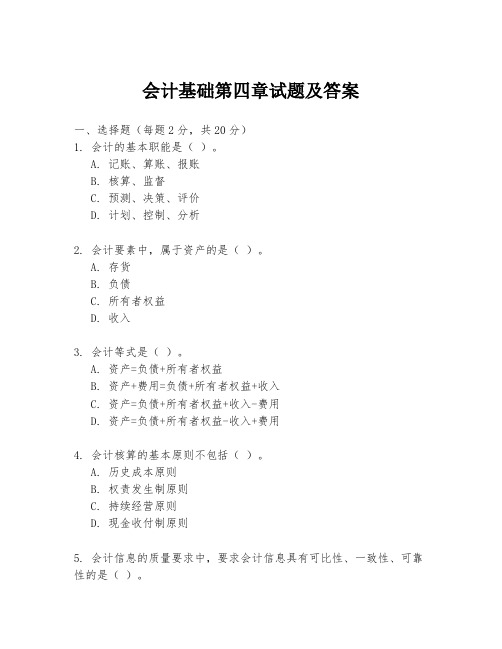
会计基础第四章试题及答案一、选择题(每题2分,共20分)1. 会计的基本职能是()。
A. 记账、算账、报账B. 核算、监督C. 预测、决策、评价D. 计划、控制、分析2. 会计要素中,属于资产的是()。
A. 存货B. 负债C. 所有者权益D. 收入3. 会计等式是()。
A. 资产=负债+所有者权益B. 资产+费用=负债+所有者权益+收入C. 资产=负债+所有者权益+收入-费用D. 资产=负债+所有者权益-收入+费用4. 会计核算的基本原则不包括()。
A. 历史成本原则B. 权责发生制原则C. 持续经营原则D. 现金收付制原则5. 会计信息的质量要求中,要求会计信息具有可比性、一致性、可靠性的是()。
B. 相关性C. 可理解性D. 可靠性6. 会计核算的基本前提不包括()。
A. 会计分期B. 货币计量B. 会计主体D. 会计政策7. 会计科目设置的原则包括()。
A. 合法性、相关性、系统性B. 合法性、系统性、可操作性C. 合法性、相关性、可操作性D. 系统性、相关性、可操作性8. 会计凭证的分类不包括()。
A. 原始凭证B. 记账凭证C. 汇总凭证D. 调整凭证9. 会计账簿的分类不包括()。
A. 日记账B. 分类账C. 总账D. 明细账10. 会计报表的编制原则不包括()。
A. 真实性C. 及时性D. 灵活性二、判断题(每题1分,共10分)1. 会计的基本职能是核算和监督。
()2. 会计要素中,负债属于资产。
()3. 会计等式是资产=负债+所有者权益+收入-费用。
()4. 会计核算的基本原则包括历史成本原则和现金收付制原则。
()5. 会计信息的质量要求中,可理解性要求会计信息必须易于理解。
()6. 会计核算的基本前提包括会计分期和货币计量。
()7. 会计科目设置的原则包括合法性、系统性和可操作性。
()8. 会计凭证的分类包括原始凭证和记账凭证。
()9. 会计账簿的分类包括日记账、分类账和总账。
会计学-企业决策的基础 答案教学资料

会计学-企业决策的基础答案管理会计作业(chapter16-20)Chapter 16 P757 16.5AChapter 16 P761 16.4BChapter 17 P802 17.3Aa. Department One overhead application rate based on machine-hours:Manufacturing Overhead= $420,000= $35 per machine-hourMachine-Hours 12,000Department Two overhead application rate based on direct labor hours:Manufacturing Overhead= $337,500= $22.50 per direct labor hourDirect Labor Hours 15,000Chapter 17 P805 17.8Ad. The Custom Cuts product line is very labor intensive in comparison to the BasicChunks product line. Thus, the company’s current practice of using direct laborhours to allocate overhead results in the assignment of a disproportionate amount of total overhead to the Custom Cuts product line. If pricing decisions are set as a fixed percentage above the manufacturing costs assigned to each product, the Custom Cuts product line is overpriced in the marketplace whereas the Basic Chunks product line is currently priced at an artificially low price in the marketplace. This probablyexplains why sales of Basic Chunks remain strong while sales of Custom Cuts are on the decline.e. The benefits the company would achieve by implementing an activity-based costingsystem include: (1) a better identification of its operating inefficiencies, (2) a betterunderstanding of its overhead cost structure, (3) a better understanding of theresource requirements of each product line, (4) the potential to increase the sellingprice of Basic Chunks to make it more comparable to competitive brands and possibly do so without having to sacrifice significant market share, and (5) the ability todecrease the selling price of Custom Cuts without having to sacrifice product quality.Chapter 18 P835 18.1a. job costing (each project of a construction company is unique)B. Ex.18.1b. both job and process costing (institutional clients may represent uniquejobs)c. job costing (each set of equipment is uniquely designed andmanufactured)d. process costing (the dog houses are uniformly manufactured in highvolumes)e. process costing (the vitamins and supplements are uniformlymanufactured in high volumes)Chapter 18 P841 18.3Ab4,000 EU @ $13.50 = $54,000Chapter 18 P845 18.2Ba. (1) $49 [($192,000 + $48,000 + $54,000) ÷ 6,000 units](2) $109 [($480,000 + $108,000 + $66,000) ÷ 6,000 units](3) $158 ($49 + $109)(4) $32 ($192,000 ÷ 6,000 units)(5) $18 ($108,000 ÷ 6,000 units)b. In evaluating the overall efficiency of the Engine Department, management wouldlook at the monthly per-unit cost incurred by that department, which is the cost of assembling and installing an engine ($109 in part a).Chapter 20 P918 20.1Ad. No. With a unit sales price of $94, the break-even sales volume in units is 54,000 units:Unit contribution margin = $94 - $84 variable costs = $10Break-even sales volume (in units) = $540,000$10= 54,000 unitsUnless Thermal Tent has the ability to manufacture 54,000 units (or lower fixed and/or variable costs), setting the unit sales price at $94 will not enable Thermal Tent to break even.Chapter 20 P918 20.2AChapter 20 P920 20.6ASales volume required to maintain current operating income:Sales Volume =Fixed Costs + Target Operating IncomeUnit Contribution Margin=$390,000 + $350,000= $20,000 units$37。
会计学企业决策的基础 课后习题 答案 chapter
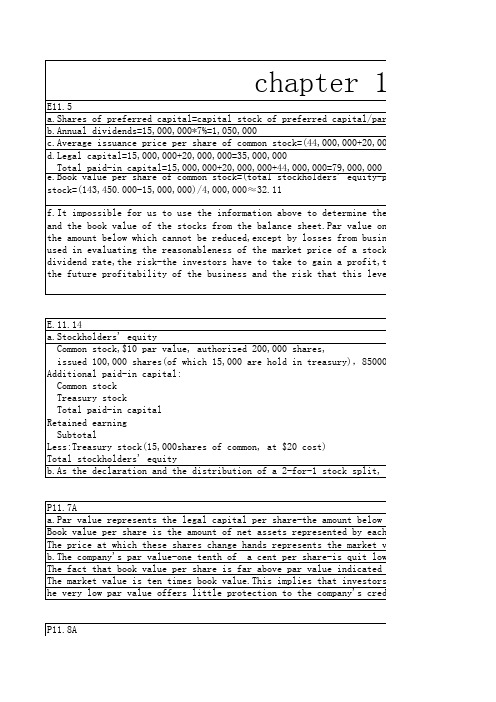
Total paid-in capital=15,000,000+20,000,000+44,000,000=79,000,000 e.Book value per share of common stock=(total stockholders' equity-preferred stock)/shares stock=(143,450.000-15,000,000)/4,000,000≈32.11
会计基础一到四章节及答案
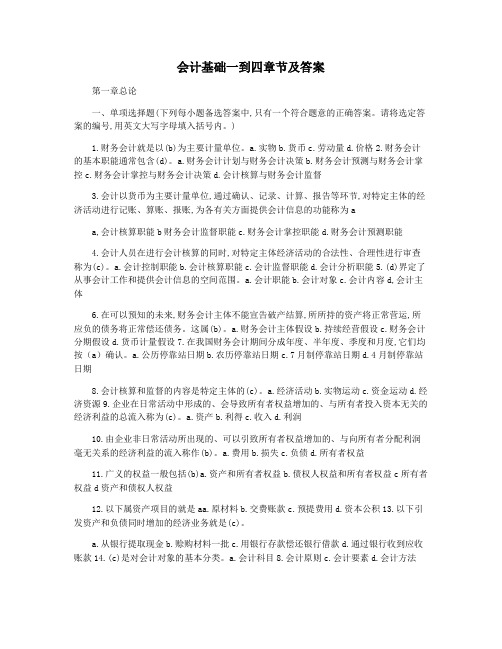
会计基础一到四章节及答案第一章总论一、单项选择题(下列每小题备选答案中,只有一个符合题意的正确答案。
请将选定答案的编号,用英文大写字母填入括号内。
)1.财务会计就是以(b)为主要计量单位。
a.实物b.货币c.劳动量d.价格2.财务会计的基本职能通常包含(d)。
a.财务会计计划与财务会计决策b.财务会计预测与财务会计掌控c.财务会计掌控与财务会计决策d.会计核算与财务会计监督3.会计以货币为主要计量单位,通过确认、记录、计算、报告等环节,对特定主体的经济活动进行记账、算账、报账,为各有关方面提供会计信息的功能称为aa,会计核算职能b财务会计监督职能c.财务会计掌控职能d.财务会计预测职能4.会计人员在进行会计核算的同时,对特定主体经济活动的合法性、合理性进行审查称为(c)。
a.会计控制职能b.会计核算职能c.会计监督职能d.会计分析职能5.(d)界定了从事会计工作和提供会计信息的空间范围。
a.会计职能b.会计对象c.会计内容d,会计主体6.在可以预知的未来,财务会计主体不能宣告破产结算,所所持的资产将正常营运,所应负的债务将正常偿还债务。
这属(b)。
a.财务会计主体假设b.持续经营假设c.财务会计分期假设d.货币计量假设7.在我国财务会计期间分成年度、半年度、季度和月度,它们均按(a)确认。
a.公历停靠站日期b.农历停靠站日期c.7月制停靠站日期d.4月制停靠站日期8.会计核算和监督的内容是特定主体的(c)。
a.经济活动b.实物运动c.资金运动d.经济资源9.企业在日常活动中形成的、会导致所有者权益增加的、与所有者投入资本无关的经济利益的总流入称为(c)。
a.资产b.利得c.收入d.利润10.由企业非日常活动所出现的、可以引致所有者权益增加的、与向所有者分配利润毫无关系的经济利益的流入称作(b)。
a.费用b.损失c.负债d.所有者权益11.广义的权益一般包括(b)a.资产和所有者权益b.债权人权益和所有者权益c所有者权益d资产和债权人权益12.以下属资产项目的就是aa.原材料b.交费账款c.预提费用d.资本公积13.以下引发资产和负债同时增加的经济业务就是(c)。
会计学:企业决策的基础财务会计分册(机械工业出版社,英文原书第15版)课后练习答案chapter05

Exercises 5.1 5.2 5.3 5.4 5.5 5.6 5.7 5.8 5.9 5.10 5.11 5.12 5.13 5.14 5.15
Topic Accounting terminology Financial statement preparation Financial statement preparation Closing and after-closing trial balance Closing and after-closing trial balance Real World: Circuit City Adequate Disclosure Closing entries of profitable firms Closing entries of unprofitable firms Adjusting versus closing entries Profitability and liquidity measures Profitability and liquidity measures Interim results Interim results Effects of accounting errors Real World: Home Depot, Inc. Using an annual report
Communication, analysis
© The McGraw-Hill Companies, Inc., 2008 Overview
© The McGraw-Hill Companies, Inc., 2008 Overview
CHAPTER 5 THE ACCOUNTING CYCLE: REPORTING FINANCIAL RESULTS
会计第四章课后习题及答案

会计第四章课后习题及答案会计第四章课后习题及答案在学习会计的过程中,课后习题是非常重要的一部分,可以帮助我们巩固所学的知识,提高解决问题的能力。
本文将为大家提供会计第四章的课后习题及答案,希望能对大家的学习有所帮助。
一、选择题1. 会计的基本任务是什么?A. 记账B. 做账C. 核算D. 预测答案:C. 核算2. 会计的基本原则包括以下哪些?A. 实体性原则B. 会计平衡原则C. 成本原则D. 所有选项都对答案:D. 所有选项都对3. 会计的记账方法有哪几种?A. 单式记账法B. 复式记账法C. 摊销记账法D. 所有选项都对答案:D. 所有选项都对4. 会计的账簿有哪几种?A. 总账B. 明细账C. 日记账D. 所有选项都对答案:D. 所有选项都对5. 会计的账户分为哪几类?A. 资产类账户B. 负债类账户C. 所有者权益类账户D. 所有选项都对答案:D. 所有选项都对二、填空题1. 会计的基本任务是对企业的经济活动进行_________和_________。
答案:核算、监督2. 会计的基本原则是_________原则、_________原则和_________原则。
答案:实体性、会计平衡、成本3. 会计的记账方法包括_________记账法、_________记账法和_________记账法。
答案:单式、复式、摊销4. 会计的账簿包括_________、_________和_________。
答案:总账、明细账、日记账5. 会计的账户分为_________类账户、_________类账户和_________类账户。
答案:资产、负债、所有者权益三、简答题1. 请简述会计的基本任务是什么?答案:会计的基本任务是对企业的经济活动进行核算和监督。
核算是指对企业的经济业务进行分类、计量、记录和汇总,以便形成财务报表。
监督是指对企业的经济活动进行监督和检查,确保企业的财务活动合法、规范和真实。
2. 请简述会计的基本原则有哪些?答案:会计的基本原则包括实体性原则、会计平衡原则和成本原则。
会计学 企业决策的基础 16版 1-5章 课后习题答案
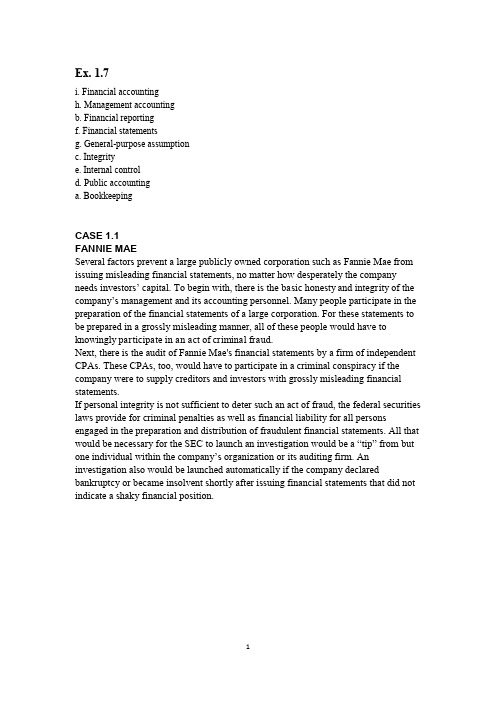
Ex. 1.7i. Financial accountingh. Management accountingb. Financial reportingf. Financial statementsg. General-purpose assumptionc. Integritye. Internal controld. Public accountinga. BookkeepingCASE 1.1FANNIE MAESeveral factors prevent a large publicly owned corporation such as Fannie Mae from issuing misleading financial statements, no matter how desperately the company needs investors’ capital. To begin with, there is the basic honesty and integrity of the company’s management and its accounting personnel. Many people participate in the preparation of the financial statements of a large corporation. For these statements to be prepared in a grossly misleading manner, all of these people would have to knowingly participate in an act of criminal fraud.Next, there is the audit of Fannie Mae's financial statements by a firm of independent CPAs. These CPAs, too, would have to participate in a criminal conspiracy if the company were to supply creditors and investors with grossly misleading financial statements.If personal integrity is not sufficient to deter such an act of fraud, the federal securities laws provide for criminal penalties as well as financial liability for all persons engaged in the preparation and distribution of fraudulent financial statements. All that would be necessary for the SEC to launch an investigation would be a “tip” from but one individual within the company’s organization or its auditing firm. An investigation also would be launched automatically if the company declared bankruptcy or became insolvent shortly after issuing financial statements that did not indicate a shaky financial position.Problem 2.1 AProblem 3.8AExercise 4.2Exercise 4.14Problem 4.5AProblem 5.2AProblem 5.5A。
会计学-企业决策的基础 答案
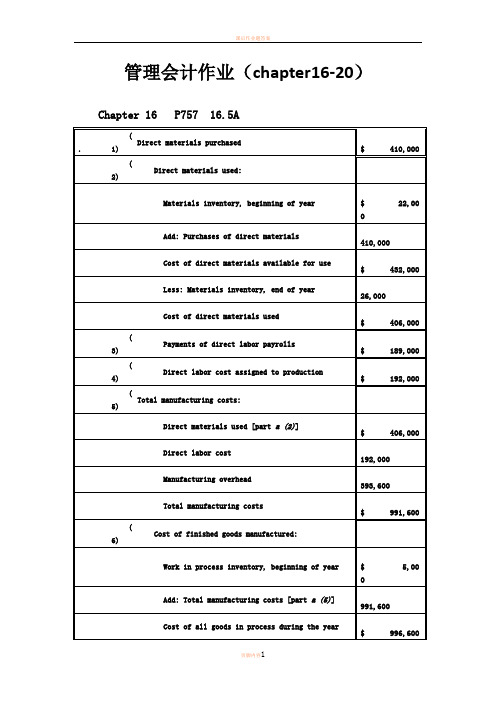
管理会计作业(chapter16-20)Chapter 16 P757 16.5AChapter 16 P761 16.4BChapter 17 P802 17.3Aa.Department One overhead application ratebased on machine-hours:Manufacturing Overhead$420,000=$35 per machine-hourMachine-Hours 12,00 0Department Two overhead application rate based on direct labor hours:Manufacturing Overhead$337,500=$22.50 per direct laborhourDirect Labor Hours 15,00 0Chapter 17 P805 17.8Ad .The Custom Cuts product line is very labor intensive in comparison to theBasic Chunks product line. Thus, the company’s current practice of using direct labor hours to allocate overhead results in the assignment of a disproportionate amount of total overhead to the Custom Cuts product line. If pricing decisions are set as a fixed percentage above the manufacturing costs assigned to each product, the Custom Cuts product line is overpriced in the marketplace whereas the Basic Chunks product line is currently priced at an artificially low price in the marketplace. This probably explains why sales of Basic Chunks remain strong while sales of Custom Cuts are on the decline.e .The benefits the company would achieve by implementing an activity-basedcosting system include: (1) a better identification of its operating inefficiencies, (2) a better understanding of its overhead cost structure, (3) a better understanding of the resource requirements of each product line, (4) the potential to increase the selling price of Basic Chunks to make it more comparable to competitive brands and possibly do so without having to sacrifice significant market share, and (5) the ability to decrease the selling price of Custom Cuts without having to sacrifice product quality.Chapter 18 P835 18.1B. Ex. 18.1a.job costing (each project of a construction company is unique)b.both job and process costing (institutional clients may represent unique jobs)c.job costing (each set of equipment is uniquely designed and manufactured)d.process costing (the dog houses are uniformly manufactured in high volumes)e.process costing (the vitamins and supplements are uniformly manufactured in high volumes)Chapter 18 P841 18.3AInputs:•Beginning WIP•StartedOutputs:•Units completed•Ending WIP•Beginning WIP•Units started•Units completed•Ending WIP•Cost of beginning WIP•Cost added during the period•Cost of goods transferredtransferred•Add ending WIP$246,000b4,000 EU @ $13.50 =$54,000Chapter 18 P845 18.2Ba .(1)$49 [($192,000 + $48,000 + $54,000) ÷ 6,000 units](2)$109 [($480,000 + $108,000 + $66,000) ÷6,000 units] (3)$158 ($49 + $109)(4)$32 ($192,000 ÷ 6,000 units)(5)$18 ($108,000 ÷ 6,000 units)b .In evaluating the overall efficiency of the Engine Department, managementwould look at the monthly per-unit cost incurred by that department, which is the cost of assembling and installing an engine ($109 in part a).Chapter 20 P918 20.1Ad .No. With a unit sales price of $94, the break-even sales volume in unitsis 54,000 units:Unit contribution margin = $94 - $84 variable costs = $10Break-even sales volume (in units)$540,000$1054,000 unitsUnless Thermal Tent has the ability to manufacture 54,000 units (or lower fixed and/or variable costs), setting the unit sales price at $94 will not enable Thermal Tent to break even.Chapter 20 P918 20.2AChapter 20 P920 20.6ASales volume required to maintain current operating income:Sales VolumeFixed Costs + TargetOperating IncomeUnit Contribution Margin$390,000 + $350,000= $20,000 units $37。
会计学基础 第四章习题参考答案
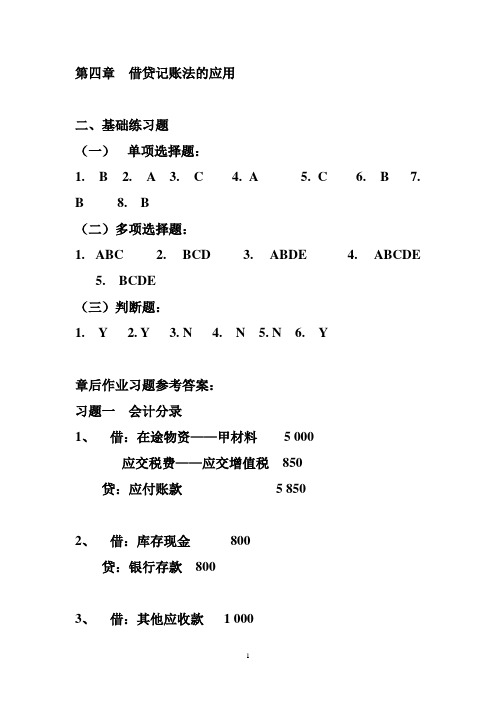
第四章借贷记账法的应用二、基础练习题(一)单项选择题:1. B2. A3. C4. A5. C6. B7.B 8. B(二)多项选择题:1.ABC2. BCD3. ABDE4. ABCDE5. BCDE(三)判断题:1. Y2. Y3. N4. N5. N6. Y章后作业习题参考答案:习题一会计分录1、借:在途物资——甲材料 5 000应交税费——应交增值税850贷:应付账款 5 8502、借:库存现金800贷:银行存款8003、借:其他应收款 1 000贷:库存现金 1 0004、借:在途物资——乙材料50 000应交税费——应交增值税8 500贷:银行存款58 5005、借:原材料——甲材料5000——乙材料50000贷:在途物资550006、借:在途物资——丙材料 2 500应交税费——应交增值税425贷:银行存款 2 925借:原材料--------丙材料 2 500贷:在途物资---丙材料 2 5007、借:应付账款 5 850贷:银行存款 5 8508、借:管理费用 1 200贷:其他应收款 1 000库存现金200习题二采购成本(1)采购费用:分配率:2500÷5000=0.5水陆——甲:4000×0.5=2000 ——乙:1000×0.5=500分配率:500÷5000=0.1 装卸——甲:4000×0.1=400——乙:1000×0.1=100 (2)编制材料采购成本计算表:习题三1、借:应付职工薪酬26 080贷:库存现金26 0802、借:在途物资----乙材料81 000应交税费——应交增值税(进项税额)13 430贷:应付账款94 4303、借:原材料----乙材料81 000贷:在途物资----乙材料81 0004、借:生产成本——A产品40 000——B产品48 000贷:原材料——甲40 000——乙48 0005、借:财务费用800贷:应付利息8006、借:生产成本——A产品 4 000——B产品8 000制造费用9 000管理费用 5 080贷:应付职工薪酬26 0807、借:银行存款60 000贷:短期借款60 0008、借:制造费用7 900管理费用 4 100贷:累计折旧12 0009、借:管理费用 2 450贷:银行存款 2 45010、借:应付利息 2 400贷:银行存款 2 40011、借:应付账款94 430贷:银行存款94 43012、借:生产成本——A产品 4 225——B产品12 675 贷:制造费用16 90013、借:库存商品——A 48 225——B 68 675贷:生产成本——A 48 225——B 68 675习题四1、借:生产成本——丙产品52 000——丁产品12 000制造费用8 000管理费用 1 500贷:原材料73 5002、借:生产成本——丙产品10 000——丁产品 2 000制造费用9 800管理费用 4 400贷:应付职工薪酬26 2003、借:生产成本——丙产品 6 000——丁产品 1 400贷:银行存款7 4004、借:制造费用 6 200管理费用 2 300贷:累计折旧8 500(2)电费分配表2003年7月分配率=7400÷74000=0.1(3)制造费用总额=8000+6200=24000(元)生产工人工资总额=10000+2000=12000(元)分配率=24000÷12000=2∴丙产品制造费用=10000×2=20000(元)丁产品制造费用=2000×2=4000(元)制造费用分配表2003年7月(4)产品成本计算表2003年7月习题五会计分录1、借:应收账款93 600贷:主管业务收入80 000 应交税费——应交增值税(销项税额)13 6002、借:销售费用 3 200贷:银行存款 3 2003、借:银行存款93 600贷:应收账款93 6004、借:银行存款70 200贷:主营业务收入60 000 应交税费——应交增值税(销项税额)10 2005、借:销售费用 1 200贷:银行存款 1 2006、借:主营业务成本87 000贷:库存商品——A 52 000——B 35 0007、借:应交税费——应交增值税12 000贷:银行存款12 0008、借:营业税金及附加 1 200贷:应交税费–城建税840---附加费3609、借:管理费用 1 500贷:库存现金 1 50010、借:银行存款 2 000贷:营业外收入 2 00011、借:财务费用 3 000贷:应付利息 3 00012、借:本年利润97 100贷:主营业务成本87 000销售费用 4 400营业税金及附加 1 200财务费用 3 000管理费用 1 50013、借:主营业务收入140 000营业外收入 2 000贷:本年利润142 00014、借:所得税费用11 225贷:应交税费---所得税11 225借:本年利润11 225贷:所得税费用11 225习题六(2)会计分录1、借:在途物资——甲 4 000——乙9 000应交税费——应交增值税(进项税额) 2 210 贷:银行存款15 2102、借:原材料——甲 4 000——乙9 000贷:在途物资——甲 4 000——乙9 0003、借:在途物资——乙材料30 000应交税费——应交增值税(进项税额)5 100 贷:应付账款35 100借:原材料——乙材料30 000贷:在途物资——乙材料30 0004、借:应付账款35 100贷:银行存款35 1005、借:库存现金12 100贷:银行存款12 1006、借:应付职工薪酬12 100贷:库存现金12 1007、借:预付账款12 000贷:银行存款12 0008、借:银行存款187 200贷:主管业务收入160 000 应交税费——应交增值税(销项税额)27 2009、借:销售费用 4 000贷:银行存款 4 00010、借:生产成本——A 5 550——B 3 330制造费用 2 110管理费用 1 110贷:应付职工薪酬12 10011、借:制造费用 3 000管理费用 1 000贷:累计折旧 4 00012、借:财务费用900贷:应付利息90013、借:制造费用 1 400管理费用600贷:预付账款 2 00014、借:生产成本——A 28 450——B 13 670制造费用 1 590管理费用590贷:原材料——甲材料30 000——乙材料14 30015、制造费用总额=2 110+3 000+1 400+1 590=8 100(元)生产总工时=10 125+6 075=16 200(元)分配率=0.5∴A为5 062.50,B为3 037.50借:生产成本—A 5 062.5—B 3 037.5贷:制造费用8 10016、借:库存商品----A 39 062.5贷:生产成本——A 39 062.517、借:主营业务成本80 000贷:库存商品80 00018、借:应交税费——应交增值税16 000贷:银行存款16 00019、借:营业税金及附加 1 600贷:应交税费——应交城市维护建设税 1 120 应交税费——教育费附加48020、借:主营业务收入160 000贷:本年利润160 00020、借:本年利润89 800贷:主营业务成本80 000营业税金及附加 1 600管理费用 3 300财务费用900销售费用 4 00021、借:所得税费用17 550贷:应交税费——应交所得税费用17 550借:本年利润17 550贷:所得税费用17 550(1)总分类账户:借库存现金贷借银行存款贷借原材料贷借固定资产贷借预付账款贷借库存商品贷借累计折旧贷借 短期借款贷借 应付利息 贷借 实收资本 贷借 盈余公积 贷借 本年利润 贷借 在途物资贷借 应付账款贷借 应交税费 贷贷借 主营业务收入 贷借 销售费用借 生产成本 贷借 制造费用贷借财务费用贷借管理费用贷借 主营业务成本 贷借营业税金及附加贷借所得税费用贷发生额及余额试算平衡表2003年7月30日。
会计基础第4章答案
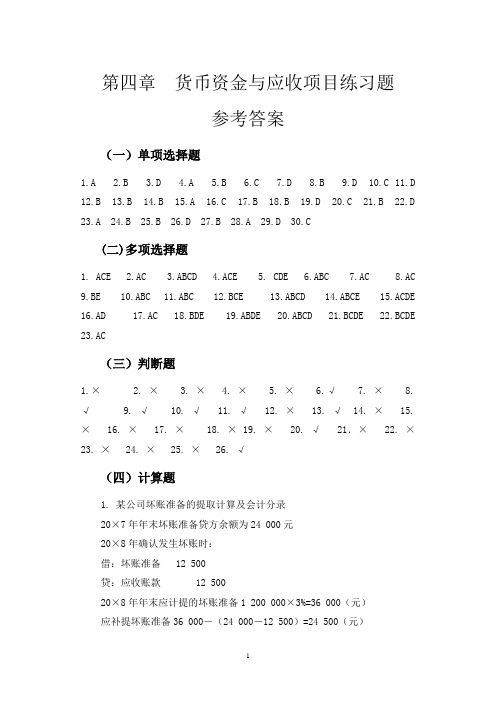
第四章货币资金与应收项目练习题参考答案(一)单项选择题1.A2.B3.D4.A5.B6.C7.D8.B9.D 10.C 11.D 12.B 13.B 14.B 15.A 16.C 17.B 18.B 19.D 20.C 21.B 22.D23.A 24.B 25.B 26.D 27.B 28.A 29.D 30.C(二)多项选择题1. ACE2.AC3.ABCD4.ACE5. CDE6.ABC7.AC8.AC9.BE 10.ABC 11.ABC 12.BCE 13.ABCD 14.ABCE 15.ACDE 16.AD 17.AC 18.BDE 19.ABDE 20.ABCD 21.BCDE 22.BCDE 23.AC(三)判断题1.×2. ×3. ×4. ×5. ×6.√7. ×8.√ 9. √ 10. √ 11. √ 12. × 13. √ 14. × 15.× 16. × 17. × 18. × 19. × 20. √ 21.× 22. ×23. × 24. × 25. × 26. √(四)计算题1. 某公司坏账准备的提取计算及会计分录20×7年年末坏账准备贷方余额为24 000元20×8年确认发生坏账时:借:坏账准备 12 500贷:应收账款 12 50020×8年年末应计提的坏账准备1 200 000×3%=36 000(元)应补提坏账准备36 000-(24 000-12 500)=24 500(元)借:资产减值损失 24500贷:坏账准备 2450020×9年6月收回以前年度已作为坏账注销的应收账款时借:应收账款 3 000贷:坏账准备 3 000借:银行存款 3000贷:应收账款 300020×9年年末应计提坏账准备 1000 000×5%=50 000(元)应补提坏账准备50 000-(36 000+3 000)=11 000(元)借:资产减值损失 11000贷:坏账准备 110002. 编制某公司8月31日的银行存款余额调节表,见表4—1。
基础会计——第四章课后测试答案解析
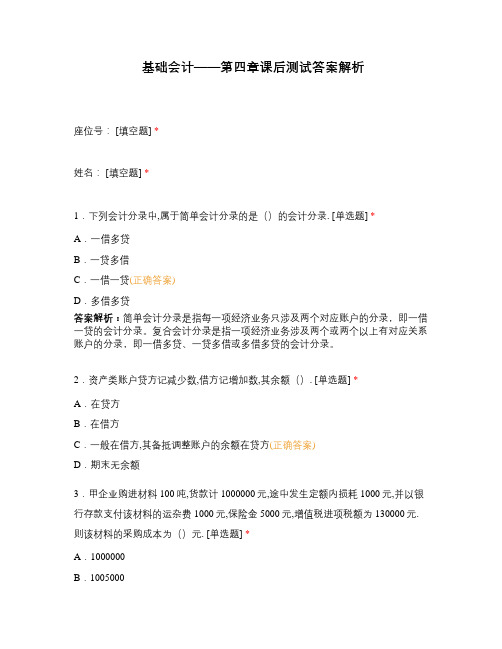
基础会计——第四章课后测试答案解析座位号: [填空题] *_________________________________姓名: [填空题] *_________________________________1.下列会计分录中,属于简单会计分录的是()的会计分录. [单选题] *A.一借多贷B.一贷多借C.一借一贷(正确答案)D.多借多贷答案解析:简单会计分录是指每一项经济业务只涉及两个对应账户的分录,即一借一贷的会计分录。
复合会计分录是指一项经济业务涉及两个或两个以上有对应关系账户的分录,即一借多贷、一贷多借或多借多贷的会计分录。
2.资产类账户贷方记减少数,借方记增加数,其余额(). [单选题] *A.在贷方B.在借方C.一般在借方,其备抵调整账户的余额在贷方(正确答案)D.期末无余额3.甲企业购进材料100吨,货款计1000000元,途中发生定额内损耗1000元,并以银行存款支付该材料的运杂费1000元,保险金5000元,增值税进项税额为130000元.则该材料的采购成本为()元. [单选题] *A.1000000B.1005000C.1006000(正确答案)D.1175000答案解析:采购成本包括材料货款、运杂费和保险金,定额损耗包含在成本中,增值税进项税计入应交税费-应交增值税(进项税额)中,故为1 000 000+1 000+5 000=1 006 000元。
4.下列各项目中,应记入“制造费用”账户的是(). [单选题] *A.生产产品耗用的材料B.机器设备的折旧费(正确答案)C.生产工人的工资D.行政管理人员的工资答案解析:选项AC计入生产成本;选项D计入管理费用。
5.“期间费用”类账户期末应(). [单选题] *A.有借方余额B.有贷方余额C.有时在借方,有时在贷方出现余额D.无余额(正确答案)答案解析:“期间费用”类账户期末转入“本年利润”,结转后无余额。
6.“生产成本”账户的期末借方余额表示(). [单选题] *A.完工产品成本B.半成品成本C.本月生产成本合计D.期末在产品成本(正确答案)答案解析:“生产成本”账户期末余额在借方,表示尚未加工完成的各项在产品成本。
会计学基础第四章练习题答案

姓名班别学号:得分第四章练习题答案一、单选题(每题1分,共30分)1。
企业接受其他单位或个人捐赠固定资产时,应贷记的账户是( A )。
A 营业外收入B 实收资本C 资本公积D 盈余公积2。
( A )是指为筹集生产经营所需资金而发生的费用。
A 财务费用B 借入资本C 投入资本D 管理费用3. 企业计提短期借款的利息支出应借记的账户是( A )。
A 财务费用B 短期借款C 应付利息D 在建工程4. 企业设置“固定资产”账户是用来反映固定资产的( A )。
A 原始价值B 磨损价值C 累计折旧D 净值5. 某制造企业为增值税一般纳税人,本期外购原材料一批,发票注明买价20000元,增值税税额3400元,入库前发生的挑选整理费用为1000元,则该批原材料的入账价值为( C )元。
A 20000B 23400C 21000D 244006. 下列费用中,不构成产品成本,而应直接计入当期损益的是( C ).A 直接材料费用B 直接人工费用C 期间费用D 制造费用7。
下列不属于期间费用的是( A )。
A 制造费用B 管理费用C 财务费用D 销售费用8。
“固定资产”科目所核算的固定资产的原始价值是( B )。
A 该固定资产投入市场初期价格B 购建当时的买价和附属支出C 不包括运杂费、安装费的买价D 现行的购置价格和附属支出9. 固定资产因损耗而减少的价值,应记入( A )账户的贷方。
A 累计折旧B 固定资产C 管理费用D 制造费用10。
不影响本期营业利润的项目是( D ).A 主营业务成本B 主营业务收入C 管理费用D 所得税费用11。
下列不属于营业外支出的项目是( D )。
A 固定资产盘亏损失B 非常损失C 捐赠支出D 坏账损失12。
下列属于营业外收入的项目是( D ).A 固定资产盘盈收益B 出售原材料的收入C 出售无形资产收益D 收到包装物押金13. 企业购入材料发生的运杂费等采购费用,应计入( B )。
A 物资采购B 材料采购C 生产D 管理费用14。
会计学-企业决策的基础 答案

管理会计作业(chapter16-20)Chapter 16 P757 16.5AChapter 16 P761 16.4BChapter 17 P802 17.3Aa. Department One overhead application rate based onmachine-hours:ManufacturingOverhead = $420,000 = $35 per machine-hour Machine-Hours 12,000Department Two overhead application rate based on direct labor hours:ManufacturingOverhead = $337,500 = $22.50 per direct labor hourDirect Labor Hours 15,000Chapter 17 P805 17.8Ad. The Custom Cuts product line is very labor intensive in comparison to the Basic Chunksproduct line. Thus, the company’s current practice of using direct labor hours toallocate overhead results in the assignment of a disproportionate amount of total overhead to the Custom Cuts product line. If pricing decisions are set as a fixed percentage above the manufacturing costs assigned to each product, the Custom Cuts product line isoverpriced in the marketplace whereas the Basic Chunks product line is currently priced at an artificially low price in the marketplace. This probably explains why sales of Basic Chunks remain strong while sales of Custom Cuts are on the decline.e. The benefits the company would achieve by implementing an activity-based costing systeminclude: (1) a better identification of its operating inefficiencies, (2) a better understanding of its overhead cost structure, (3) a better understanding of the resource requirements of each product line, (4) the potential to increase the selling price of Basic Chunks to make it more comparable to competitive brands and possibly do so without having to sacrificesignificant market share, and (5) the ability to decrease the selling price of Custom Cuts without having to sacrifice product quality.Chapter 18 P835 18.1B. Ex.18.1a. job costing (each project of a construction company is unique)b . both job and process costing (institutional clients may represent unique jobs)c. job costing (each set of equipment is uniquely designed andmanufactured)d . process costing (the dog houses are uniformly manufactured in high volumes)e. process costing (the vitamins and supplements are uniformlymanufactured in high volumes)Chapter 18 P841 18.3Ab4,000 EU @ $13.50 = $54,000Chapter 18 P845 18.2Ba. (1) $49 [($192,000 + $48,000 + $54,000) ÷ 6,000 units](2) $109 [($480,000 + $108,000 + $66,000) ÷ 6,000 units](3) $158 ($49 + $109)(4) $32 ($192,000 ÷ 6,000 units)(5) $18 ($108,000 ÷ 6,000 units)b. In evaluating the overall efficiency of the Engine Department, management wouldlook at the monthly per-unit cost incurred by that department, which is the cost of assembling and installing an engine ($109 in part a).Chapter 20 P918 20.1Ad. No. With a unit sales price of $94, the break-even sales volume in units is 54,000 units:Unit contribution margin = $94 - $84 variable costs = $10Break-even sales volume (in units) = $540,000$10= 54,000 unitsUnless Thermal Tent has the ability to manufacture 54,000 units (or lower fixed and/or variable costs), setting the unit sales price at $94 will not enable Thermal Tent to break even.Chapter 20 P918 20.2AChapter 20 P920 20.6ASales volume required to maintain current operating income:Sales Volume =Fixed Costs + Target OperatingIncomeUnit Contribution Margin=$390,000 + $350,000= $20,000 units$37c.Current AfterCapacity Expansion(20,000Units)(25,000 Units) Total contribution margin ($37 per unit) $ 740,000 $ 925,000Less: Fixed costs390,000530,000*Operating income at full capacity $ 350,000$ 395,000*$390,000 + additional depreciation per year on newmachinery, $140,000 (20% of $700,000).盛年不重来,一日难再晨。
- 1、下载文档前请自行甄别文档内容的完整性,平台不提供额外的编辑、内容补充、找答案等附加服务。
- 2、"仅部分预览"的文档,不可在线预览部分如存在完整性等问题,可反馈申请退款(可完整预览的文档不适用该条件!)。
- 3、如文档侵犯您的权益,请联系客服反馈,我们会尽快为您处理(人工客服工作时间:9:00-18:30)。
SOLUTIONS TO EXERCISESEx 4–1 a. Book valueb. Materialityc. Matching principled. Unrecorded revenuee. Adjusting entriesf. Unearned revenueg. Prepaid expensesh. None (This is an example of “depreciation expense.”)Ex. 4–2 Income Statement Balance SheetAdjustingEntryab NE I D NE I Dc I NE I I NE Id NE I D NE I De NE I D D NE Df I NE I NE D I Ex. 4–3 a. Rent Expense ......................................................... 240,000Prepaid Rent .................................................. 240,000 To record rent expense for May ($1,200,000 ÷ 5 months =$240,000 per month).b. Unearned Ticket Revenue ......................................... 148,800Ticket Revenue .............................................. 148,800 To record earning portion of season ticket revenuerelating to May home games.Ex. 4–4 a. (1) Interest Expense (375)Interest Payable (375)$50,000 x 9% annual rate x 1/12 = $375.(2) Accounts Receivable ............................................ 10,000Consulting Fees Earned ................................ 10,000 To record ten days of unbilled consulting fees at$1,000 per day.b. $2,250 ($50,000 x 9% x 6/12 = $2,250)c. $15,000 ($25,000 - $10,000 earned in December, 2002)Ex. 4–5 a. The balance of TWA’s Advance Ticket Sales account represents unearned revenue—that is, amounts collected from customers prior to rendering therelated services (air travel). As TWA has an obligation to render these services,the Advanced Ticket Sales account appears among the liabilities in TWA’sbalance sheet.b. TWA normally reduces the balance of this liability account by renderingservices to customers—that is, by providing flights for which the customershave purchased tickets. On some occasions, however, TWA reduces the balanceof this liability by making cash refunds to customers.Ex. 4–6 a. 1. I nterest Expense ..................................................... 1,200Interest Payable .............................................. 1,200 To record interest accrued on bank loan duringDecember.2. D epreciation Expense: Office Building .......................... 1,100Accumulated Depreciation: Office Building ............ 1,100 To record depreciation on office building ($330,000 ÷ 25years ⨯1/12 = $1,100).3. A ccounts Receivable ................................................ 64,000Marketing Revenue Earned ................................ 64,000 To record accrued Marketing revenue earned inDecember.4. I nsurance Expense (150)Prepaid Insurance (150)To record insurance expense (1,800 ÷ 12 months =$150).5. U nearned Revenue .................................................. 3,500Marketing Revenue Earned ................................ 3,500 To record portion of unearned revenue that had becomeearned in December.6. S alaries Expense ..................................................... 2,400Salaries Payable .............................................. 2,400 To record accrued salaries in December.b. $62,650 ($64,000 + $3,500 - $1,200 - $1,100 - $150 - $2,400).Ex. 4–7 a. The total interest expense over the life of the note is $5,400 ($120,000 ⨯ .09 ⨯6/12 = $5,400).The monthly interest expense is $900 ($5,400 ÷ 6 = $900).b. The liability to the bank at December 31, 2002, is $121,800 (Principal, $120,000+ $1,800 accrued interest).c. 2002Oct. 31 Cash ......................................................... 120,000Notes Payable ..................................... 120,000 Obtain from bank six-month loan with interest at9% a year.d. Dec. 31 Interest Expense (900)Interest Payable (900)To accrue interest expense for December on notepayable ($120,000 ⨯ 9% ⨯1/12).e. The liability to the bank at March 31, 2003, is $124,500, consisting of $120,000principal plus $4,500 accrued interest for five months.Ex. 4–8 a. May 1 Cash ......................................................... 300,000Notes Payable ..................................... 300,000 Obtained a three-month loan from National Bankat 12% interest per year.May 31 Interest Expense ......................................... 3,000Interest Payable .................................. 3,000 To record interest expense for May on notepayable to National Bank ($300,000 ⨯ 12% ⨯1/12 =$3,000).b. May 1 Prepaid Rent .............................................. 180,000Cash ................................................ 180,000 Paid rent for six months at $30,000 per month.May 31 Rent Expense ............................................. 30,000Prepaid Rent ...................................... 30,000 To record rent expense for the month of May.c. May 2 Cash ......................................................... 910,000Unearned Admissions Revenue ................ 910,000 Sold season tickets to the 70-day racing season.May 31 Unearned Admissions Revenue ........................ 260,000Admissions Revenue ............................. 260,000 To record admissions revenue from the 20 racingdays in May ($910,000 ⨯ 20/70 = $260,000).d. May 4 No entry required.e. May 6 Prepaid Printing .......................................... 12,000Cash ................................................ 12,000 Printed racing forms for first 30 racing days.May 31 Printing Expense ......................................... 8,000Prepaid Printing .................................. 8,000 To record printing expense for 20 racing days inMay.f. May 31 Concessions Receivable ................................. 16,500Concessions Revenue............................ 16,500 Earned 10% of refreshment sales of $165,000during May.- --Something to Consider:Effects of omission of May 31 adjusting entry for rent expense on May 31financial statements:Revenue Not affectedExpenses Understated (by May’s rent of $30,000)Net Income Overstated (because May rent expense was not recognized)Assets Overstated (Prepaid Rent should be reduced by portionexpired in May)Liabilities Not affectedOwners’ Equity Overstated (because net income is overstated)Ex. 4–9 a. Materiality refers to the relative importance of an item. An item is material if knowledge of it might reasonably influence the decisions of users of financialstatements. If an item is immaterial, by definition it is not relevant to decisionmakers.Accountants must account for material items in the manner required bygenerally accepted accounting principles. However, immaterial items may beaccounted for in the most convenient and economical manner.b. Whether a specific dollar amount is “material” depends upon the (1) size of theamount and (2) nature of the item. In evaluating the size of a dollar amount,accountants consider the amount in relation to the size of the organization.Based solely upon dollar amount, $2,500 is not material in relation to thefinancial statements of a large, publicly owned corporation. For a smallbusiness however, this amount could be material.In addition to considering the size of a dollar amount, accountants must alsoconsider the nature of the item. The nature of an item may make the item“material” to users of the financial statements regardless of its dollar amount.Examples might include bribes paid to government officials, or theft ofcompany assets or other illegal acts committed by management.In summary, one cannot say whether $2,500 is a material amount. The answerdepends upon the related circumstances.c. Two ways in which the concept of materiality may save time and effort foraccountants are:1. Adjusting entries may be based upon estimated amounts if there is little orno possibility that the use of an estimate will result in material error. Forexample, an adjusting entry to reflect the amount of supplies used may bebased on an estimate of the cost of supplies remaining on hand.2. Adjusting entries need not be made to accrue immaterial amounts ofunrecorded expenses or unrecorded revenue. For example, no adjustingentries normally are made to record utility expense payable at year-end.Ex. 4–10 a. None (or Materiality). Accounting for immaterial items is not “wrong” or a “violation” of generally accepted accounting prin ciples; it is merely a waste oftime. The bookkeeperis failing to take advantage of the concept of materiality, which permits chargingimmaterial costs directly to expense, thus eliminating the need to recorddepreciation in later periods.b. Matching.c. Realization.Ex. 4–11 a. Accounts likely to have required an adjusting entry are:1. Investments2. Accounts Receivable3. Inventories4. Prepaid Expenses5. Deferred Income Taxes6. Buildings7. Machinery and Equipment8. Intangible Assets9. Accounts Payable10. Accrued Liabilities11. Income Taxes Payable12. Deferred Compensation and Other LiabilitiesNote to the Instructor:The adjustments required for many of the accountslisted above are discussed in subsequent chapters. Some are beyond the scopeof an introductory course.SOLUTIONS TO PROBLEMS20 Minutes, Easy PROBLEM 4–1FLORIDA PALMS COUNTRY CLUBPROBLEM 4–1FLORIDA PALMS COUNTRY CLUB (concluded)b.1. Accruing unpaid expenses.2. Accruing uncollected revenue.3. Converting liabilities to revenue.4. Converting assets to expenses.5. Accruing unpaid expenses.6. Converting assets to expenses.7. No adjusting entry required.8. Accruing unpaid expenses.c. The clubhouse was built in 1925 and has been fully depreciated for financial accountingpurposes. The net book value of an asset reported in the balance sheet does not reflect the asset’s fair market value. Likewise, depreciation expense rep orted in the income statement does not reflect a decline in fair market value, physical obsolescence, or wear-and-tear.40 Minutes, Medium PROBLEM 4–2PROBLEM 4–2ENCHANTED FOREST (concluded)b.1. Accruing uncollected revenue.2. Accruing unpaid expenses.3. Converting assets to expenses.4. No adjusting entry required.5. Accruing unpaid expenses.6. Accruing uncollected revenue.7. Converting liabilities to revenue.8. Accruing unpaid expenses.9. Accruing unpaid expenses.c. Income Statement Balance SheetAdjustment Revenue Expenses =NetIncome Assets = Liabilities +Owners’Equity1. I NE I I NE I2. NE I D NE I D3. NE I D D NE D4. NE NE NE NE NE NE5. NE I D NE I D6. I NE I I NE I7. I NE I NE D I8. NE I D NE I D9. NE I D NE I Dd. $340 ($12,000 x 0.85% x 4/12)e. Original cost of buildings .......................................................$600,000 Accumulated depreciation: buildings (prior to adjusting entry 3in part a) ...........................................................................$310,000 December depreciation expense from part a ..............................2,000 Accumulated depreciation, buildings, 12/31 ...............................(312,000) Net book value at December 31 ..............................................$288,00SEA CAT a. (1) Age of the catamaran in months = accumulated depreciation monthlydepreciation. Useful life is given as 10 years, or 120 months.Cost $46,200 120 months = $385 monthly depreciation expense.Accumulated depreciation of $9,240 $385 monthly depreciation = 24 months.(2) Tickets used in June (14)5Tickets outstanding on June 30 ($825$15) (55)Tickets sold to resort hotel on June 1 (20)(3) Prepaid rent of $6,000 5 months remaining = $1,200 monthlyrental expense.(4) $1,400 x 12/8 = $2,100 original cost.Since 4 months of the 12-month life of the policy have expired, the $1,400 ofunexpired insurance applies to the remaining 8 months. This indicates a monthlycost of $175, computed as $1,400 8. Therefore, the 12-month policy originallycost $2,100, or 12 x $175.PROBLEM 4–4CAMPUS THEATER (concluded) b. (1) Eight months (bills received January through August). Utilities bills are recorded asmonthly bills are received. As of August 31, eight monthly bills should have beenreceived.(2) Seven months (January through July). Depreciation expense is recorded only inmonth-end adjusting entries. Thus, depreciation for August is not included in theAugust unadjusted trial balance.(3) Twenty months ($14,000 $700 per month).c. Corporations must pay their income taxes in several installment payments throughoutthe year. The balance in the Income T axes Expense account represents the total amount of income taxes expense recognized since the beginning of the year. But Income T axes Payable represents only the portion of this expense that has not yet been paid. In the example at hand, the $4,740 in income taxes payable probably represents only theincome taxes expense accrued in July, as Pickwood should have paid taxes accrued in the first two quarters by June 15.50 Minutes, Strong PROBLEM 4–5KEN HENSLEY ENTERPRISES, INC.PROBLEM 4–5KEN HENSLEY ENTERPRISES, INC. (continued)c. Monthly rent expense for the last two months of 2002 was $2,000 ($6,000 3months). The $21,000 rent expense shown in the studio’s trial balance includes a$2,000 rent expense for November, which means that total rent expense for January through October was $19,000 ($21,000 - $2,000). The monthly rent expense in these months must have been $1,900 ($19,000 10 months). Thus, it appears that thestudio’s monthly rent increased by $100 (from $1,900 t o $2,000) in November andDecember.15 Minutes, Medium PROBLEM 4–6KOYNE CORPORATION。
